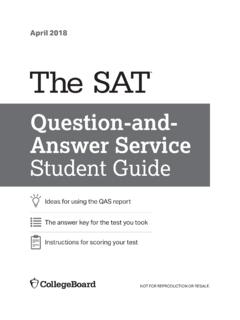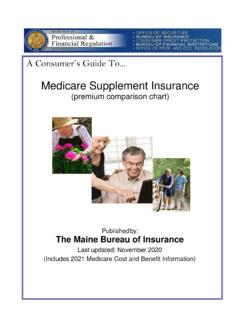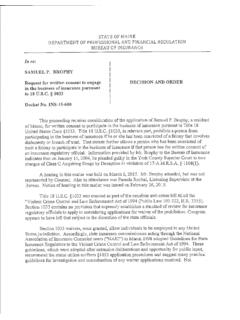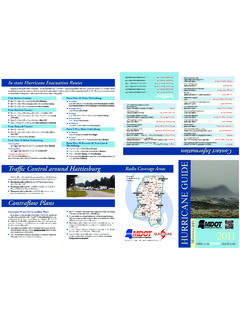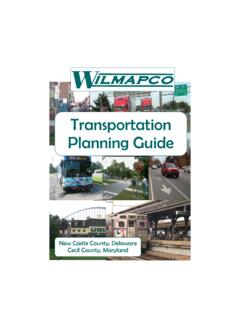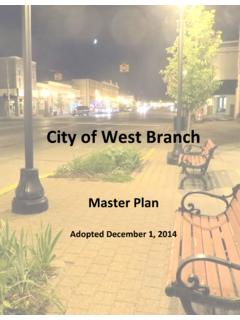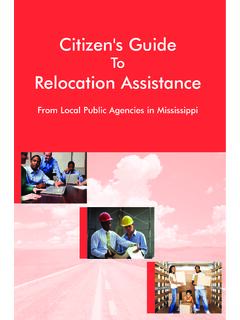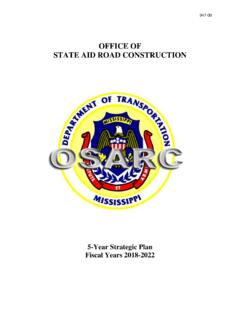Transcription of Maine Department of Transportation
1 Maine Department of Transportation Title VI Public Participation Template for Subrecipients January 2015 Office Civil Rights State House Station 16 Augusta, Maine 04333 (207) 624-3042 Information: Every three years, on a date determined by the Maine Department of Transportation (MaineDOT), each recipient is required to submit the following plan as part of their Title VI Program. For immediate reference please review page(s) 25-26 of FTA C Below you will find an outline of the Title VI Public Participation Plan, as required by US-DOT Federal Transit Administration. This document explicitly describes the proactive strategies, procedures, and desired outcomes that underpin the recipient s public participation activities.
2 Your Title VI Public Participation Plan must contain each of these individual parts to be considered complete. 1. Cover Page (applicable if a detailed plan, otherwise use a section heading) a. Name of transit provider b. Title VI Public Participation Plan c. Date Completed d. Contact information for Title VI Coordinator 2. General Information Section a. Public involvement as a necessity i. Why is public involvement necessary? ii. When is public involvement necessary? iii. How does public involvement benefit your transit or Department ? Sample: The Federal and State government mandate public involvement, because it helps to guide Department decisions in providing public Transportation services.
3 Public involvement also benefits [name of sub recipient/transit provider] and the public, by allowing for the development of services that meet the needs of area citizens /customers. The Federal government mandates public involvement prior to raising fares, implementing major reductions in service, or applying for grants/loans to finance Transportation improvement projects. 3. Public Participation/ Engagement Recipients have wide latitude to determine how, when, and how often specific public participation activities should take place, and which specific measures are most appropriate. a. Public Meetings i.
4 What meetings, if any, are open to the public? 1. Customer Information Meetings, Advisory Board Meetings, Public Hearings and other community meetings. ii. How do you inform the public of upcoming meetings and agendas? iii. Do you employ different meeting sizes and formats to accommodate the minority, disabled, and limited English proficiency (LEP) populations? b. Coordination i. Other agencies 1. Department of labor, Job Link, local churches, local food pantry, medical facilities, social services, educational institutions, and other organizations provide a medium to educate and solicit feedback on current services.
5 Ii. Community events 1. Senior center health fairs, non-profit events, and other community events serve as a way to provide education about your services. iii. Interpretation services c. Public Studies: As per requirements of [49 Sections 5307 (b)] and [5307 (c)(I)] [name of sub recipient/transit provider] will develop and/or consider a process to study public comment before raising a fare or carrying out a major reduction in Transportation service. i. Consider conducting an annual customer survey 4. Public Outreach Plan a. How do you advertise? i. Possible outreach mediums include local television channels, radio shows or podcasts, and newspaper ads.
6 B. Outreach to minority, LEP, and other underserved populations: The Public Participation Plan should include information about outreach methods to engage minority and limited English proficiency (LEP) populations, as well as a summary of outreach efforts made since the last Title VI Program submission. i. How do you determine if there are minority/LEP populations in your area? ii. What steps are being taken to engage minority and LEP populations? iii. What steps are being taken to engage underserved populations such as the disabled or those with low-income? iv. Do you schedule meetings at times and locations that are convenient and accessible for minority and LEP communities?
7 V. Do you coordinate with community and faith based organizations, educational institutions, and other organizations to implement public engagement strategies that reach out specifically to members of affected minority and/or LEP communities? Efforts to involve minority and LEP populations can include both comprehensive measures as well as targeted measures to address linguistic, institutional, cultural, economic, historical, or other barriers that may prevent minority and LEP persons from effectively participating in a recipient s decision-making process. 5. Type o f Public Involvement a. What public should be involved: It is important to involve as many individuals as possible in order to gain the support and development of public Transportation .
8 Potential and current riders Non-riders Business and community leaders/groups Government officials City Council and other City Departments Faith based community Academia and educational institutions Medical facilities/long term care centers

